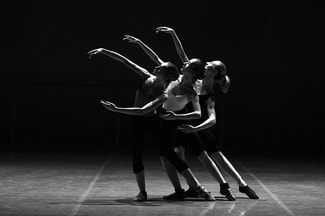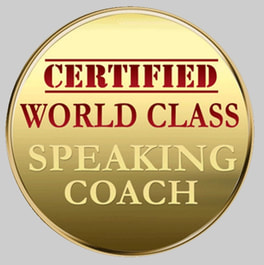
The first time I ever competed in a public speaking contest, I received feedback from two talented mentors. The first told me I moved around too much on the stage. The second told me I should move around more.
That was my first introduction to the fact that public speaking is an art as much as a science. Sometimes there’s no wrong or right. In fact, both my mentors were correct in their own way. I moved around too much “without purpose”. However I didn’t move effectively when I should have.
This begs the questions: How? When? Where? Why? … and so on.
Don’t worry, stage movement is quite simple. Start with the first most important guideline: don’t do anything you don’t feel comfortable doing. That may seem obvious, but if you apply this to stage movement, it’s obvious that you shouldn’t move unless you feel comfortable doing it. If you telegraph discomfort, your audience will start to feel the same. Therefore, the good news is, stage movement is optional. That is to say, you could be on a massive stage with a single spotlight shining on you, and you don’t have to move to be a successful speaker.
If you watch different stand up comedians, some love to move, some stay put behind the mic. Both are correct because they are doing what is unique and comfortable for them. Take note.
There are advantages to stage movement. Firstly, you can use the stage to paint pictures, interact with imaginary characters, and to “work” different sections of the audience. If you decide not to do any of these, make sure your script and vocal tonality makes up for the shortfall in picture painting, characterization, and so on.
Secondly, it may not be appropriate or even possible to move around. For example, if you are delivering a funeral eulogy in a church, it’s best to stay put. Churches also tend to have podiums or pulpits. Our second tip is to check out whatever venue you are speaking at and see what the stage looks like.
What is the best posture for speaking behind a podium or pulpit?
It’s important to adopt the high-powered pose that we covered in the blog article on posture. When you are behind a podium, pulpit (or wedding table) the audience can only see the top half of your body. That means you can still use your hands, face and eyes… so use them as much as is appropriate. Don’t stand like a stiff board even if you are partially obscured from view.
If you have a stage with space it’s important to make all movement sideways. Avoid moving forward and back unless you need to work with props, such as laptops and screens. If you are working with a prop (or volunteer) keep facing towards the audience, like a weather presenter on television. Avoid turning your back on your audience (as much as possible).
How do you move from side to side then? And when?
In your mind pick three hot-spots on the stage – all at the same distance from the audience. The first hot spot is right smack in the centre of the stage. Half of the audience is to your left and half to your right. If there is an aisle down the centre of the audience, the centre spot is right in line with this.
The next hot spot will be half-way along the left half of the audience. Imagine splitting the left half of the audience into two equal parts with an aisle down the middle. This is the second spot. Call it the left.
The final one is half-way along the right-half (the mirror image of the left spot).
Now you have three hot spots: left, middle, right. Feel free to move between them, but only occasionally, and with purpose. Start in the middle, at the beginning of your speech. To move from one spot to another, simply take a few steps, sweeping one foot in front of the other (in dancing they call this the side-step). In between movements, stay anchored in one spot for at least two sentences, if not a whole paragraph. Go from centre to left. Then hold it. Then move from left back to middle. Then hold. Then move from middle to right… and so on.
Even on a massive stage with a concert size audience you only need to step two to 5 steps if you prefer.
By the way, if you don’t like to move and you would rather stay in one spot, pick the centre spot and anchor your feet there. To take in both sides of the audience twist your body slightly at the hips to angle the top half of your body towards each section of the audience. Swivel back and forth as often as you like to give each section some eye contact.
When you get the hang of movement you will develop your own swagger. This is important and it’s unique to everyone. A rose doesn’t have to be a chamomile.
That was my first introduction to the fact that public speaking is an art as much as a science. Sometimes there’s no wrong or right. In fact, both my mentors were correct in their own way. I moved around too much “without purpose”. However I didn’t move effectively when I should have.
This begs the questions: How? When? Where? Why? … and so on.
Don’t worry, stage movement is quite simple. Start with the first most important guideline: don’t do anything you don’t feel comfortable doing. That may seem obvious, but if you apply this to stage movement, it’s obvious that you shouldn’t move unless you feel comfortable doing it. If you telegraph discomfort, your audience will start to feel the same. Therefore, the good news is, stage movement is optional. That is to say, you could be on a massive stage with a single spotlight shining on you, and you don’t have to move to be a successful speaker.
If you watch different stand up comedians, some love to move, some stay put behind the mic. Both are correct because they are doing what is unique and comfortable for them. Take note.
There are advantages to stage movement. Firstly, you can use the stage to paint pictures, interact with imaginary characters, and to “work” different sections of the audience. If you decide not to do any of these, make sure your script and vocal tonality makes up for the shortfall in picture painting, characterization, and so on.
Secondly, it may not be appropriate or even possible to move around. For example, if you are delivering a funeral eulogy in a church, it’s best to stay put. Churches also tend to have podiums or pulpits. Our second tip is to check out whatever venue you are speaking at and see what the stage looks like.
What is the best posture for speaking behind a podium or pulpit?
It’s important to adopt the high-powered pose that we covered in the blog article on posture. When you are behind a podium, pulpit (or wedding table) the audience can only see the top half of your body. That means you can still use your hands, face and eyes… so use them as much as is appropriate. Don’t stand like a stiff board even if you are partially obscured from view.
If you have a stage with space it’s important to make all movement sideways. Avoid moving forward and back unless you need to work with props, such as laptops and screens. If you are working with a prop (or volunteer) keep facing towards the audience, like a weather presenter on television. Avoid turning your back on your audience (as much as possible).
How do you move from side to side then? And when?
In your mind pick three hot-spots on the stage – all at the same distance from the audience. The first hot spot is right smack in the centre of the stage. Half of the audience is to your left and half to your right. If there is an aisle down the centre of the audience, the centre spot is right in line with this.
The next hot spot will be half-way along the left half of the audience. Imagine splitting the left half of the audience into two equal parts with an aisle down the middle. This is the second spot. Call it the left.
The final one is half-way along the right-half (the mirror image of the left spot).
Now you have three hot spots: left, middle, right. Feel free to move between them, but only occasionally, and with purpose. Start in the middle, at the beginning of your speech. To move from one spot to another, simply take a few steps, sweeping one foot in front of the other (in dancing they call this the side-step). In between movements, stay anchored in one spot for at least two sentences, if not a whole paragraph. Go from centre to left. Then hold it. Then move from left back to middle. Then hold. Then move from middle to right… and so on.
Even on a massive stage with a concert size audience you only need to step two to 5 steps if you prefer.
By the way, if you don’t like to move and you would rather stay in one spot, pick the centre spot and anchor your feet there. To take in both sides of the audience twist your body slightly at the hips to angle the top half of your body towards each section of the audience. Swivel back and forth as often as you like to give each section some eye contact.
When you get the hang of movement you will develop your own swagger. This is important and it’s unique to everyone. A rose doesn’t have to be a chamomile.


 RSS Feed
RSS Feed
